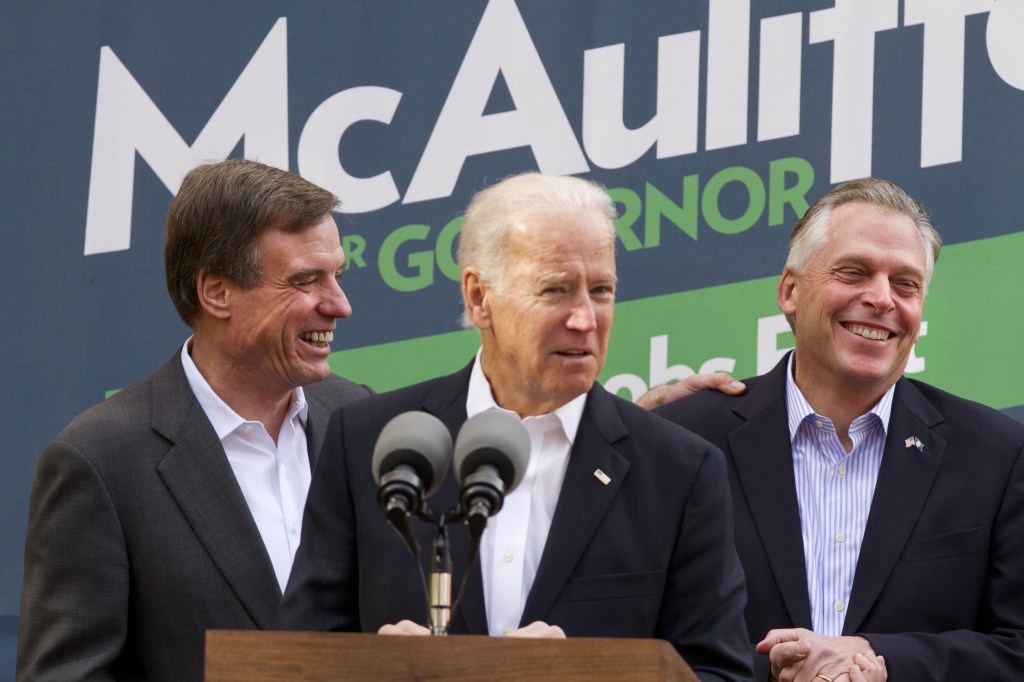WARRENTON, Va. — To appreciate their vastly different strategies in the race for Virginia governor, simply look at how the candidates spent Monday, the final full day of campaigning before polls open.
Ken Cuccinelli raced from stop to stop, trying to overcome a deficit in the polls, a crush of negative ads and a lingering wariness among fellow Republicans about his deeply conservative views. His rival, Terry McAuliffe, enjoyed a last-minute visit from Vice President Joe Biden and pledged to use the national health care law to give 400,000 Virginians health care coverage.
Their approaches capture the essence of the race: Cuccinelli, the current attorney general, turned to hand-to-hand campaigning to motivate his most loyal supporters; McAuliffe, flush with cash and ahead in the polls, leaned on television ads and turned to top national Democrats to perhaps give him his first job in elected office.
Neither, really, had much of an alternative.
Cuccinelli is out of cash and hoping voters’ frustrations with the federal health care law will energize his conservative base. “Tomorrow in Virginia is a referendum on Obamacare,” Cuccinelli said.
McAuliffe, too, tried to inspire his supporters to vote Tuesday. “We will work our hearts out for you over the course of the next four years,” McAuliffe said at an Annandale rally with Biden.
Biden warned Democrats not to coast.
“There’s only one place the tea party can compete with us, and that is they do turn out their base,” Biden said in an Annandale backyard. “Don’t take this for granted, man.”
From the start, the campaign shaped up to be a barometer of voters’ moods and a test of whether a swing-voting state like Virginia could elect a tea party-style governor. As one of just two races for governor nationwide, political strategists eyed the race for clues about what would work for 2014’s midterm elections when control of Congress is up for grabs.
Republicans bet a deeply conservative candidate would be their best shot, passing over a lieutenant governor for a crusader against the federal health care law. Democrats chose a loyal partisan who once led the Democratic National Committee and recruited pals Bill and Hillary Rodham Clinton to raise millions for him and rally the party faithful.
The race is going to be decided by the few Virginians who choose to vote. The state Board of Elections chief says turnout could be as low as 30 percent of registered voters, and the campaigns see 40 percent turnout as the goal. The lower the turnout, the better Cuccinelli’s chances.
That’s not to say the race has been virtuous. Negative advertising has been the norm, and McAuliffe enjoyed a 10-to-1 advantage on the air in the campaign’s final weeks. He raised $35 million to Cuccinelli’s $18 million.
The lopsided nature continued with outside groups, too. Millions of dollars poured in to criticize the candidates on gun rights, abortion and climate change.
“In 2009, there was a much narrower focus on the issues. It was very much a jobs and economy election,” said Rep. Rob Wittman, R-Va. “This time, there are so many issues. And none of them really answer the question about what the next governor of Virginia would do in the job.”
Send questions/comments to the editors.



Success. Please wait for the page to reload. If the page does not reload within 5 seconds, please refresh the page.
Enter your email and password to access comments.
Hi, to comment on stories you must . This profile is in addition to your subscription and website login.
Already have a commenting profile? .
Invalid username/password.
Please check your email to confirm and complete your registration.
Only subscribers are eligible to post comments. Please subscribe or login first for digital access. Here’s why.
Use the form below to reset your password. When you've submitted your account email, we will send an email with a reset code.